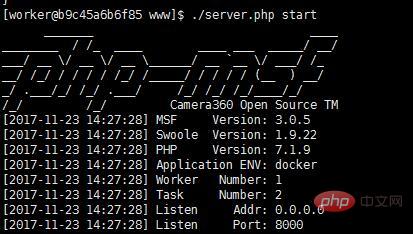What container is used to deploy php?
Docker is an open source application container engine that allows developers to package their applications and dependency packages into a portable image, and then publish it to any popular Linux or Windows machine, and can also implement virtualization change. Containers completely use the sandbox mechanism and will not have any interfaces with each other.

The classic LNMP (linux nginx php mysql) environment has many ready-made deployment scripts, but today when Docker is popular, many students still have some ideas on how to deploy. problem, so this article briefly introduces how to use Docker and docker-compose to deploy php applications on the server. (Recommended learning: PHP video tutorial)
Install and deploy in Docker, use its Docker image directly:
-p 2201:22 : In order to facilitate ssh login to the open port mapping of the container, it doesn't matter if you don't use it, because you can use docker exec
-p 81:8000: Mainly to map the 8000 port of the container (phpmsf default listening port), this The port can be changed, according to the changed port
-v: Mainly for the convenience of file mapping during development time, /home/worker/data/www/ is the default web file directory, according to the changed directory
$ docker run -dit --name phpmsfdemo -p 2201:22 -p 81:8000 -v /data/webroot/:/home/worker/data/www/ registry.cn-hangzhou.aliyuncs.com/pinguo-ops/php-msf-docker
php-msf image running container, php running environment
Deployment code
After the container is successfully deployed, the code can be deployed directly in the container.
The direct installation code uses php-msf-docker, which contains an installer.php. By running this file, you can directly download the framework and application directory.
For example, to enter the container, first git clone php-msf-docer, for example, I clone to the /home/worker/data folder.
$ git clone https://github.com/pinguo/php-msf-docker.git
Enter php-msf-docker, run installer.php:
$ php installer.php start
Then the installation directory and application name will be selected, and then the configuration will be successful:

It will start by default if the configuration is successful. If it does not start by default, you can enter the directory to start it manually:

Manually start it and enter the installation directory, and then run the server That’s it:
$ php server.php start
The above is the detailed content of What container is used to deploy php?. For more information, please follow other related articles on the PHP Chinese website!

Hot AI Tools

Undresser.AI Undress
AI-powered app for creating realistic nude photos

AI Clothes Remover
Online AI tool for removing clothes from photos.

Undress AI Tool
Undress images for free

Clothoff.io
AI clothes remover

AI Hentai Generator
Generate AI Hentai for free.

Hot Article

Hot Tools

Notepad++7.3.1
Easy-to-use and free code editor

SublimeText3 Chinese version
Chinese version, very easy to use

Zend Studio 13.0.1
Powerful PHP integrated development environment

Dreamweaver CS6
Visual web development tools

SublimeText3 Mac version
God-level code editing software (SublimeText3)

Hot Topics
 CakePHP Project Configuration
Sep 10, 2024 pm 05:25 PM
CakePHP Project Configuration
Sep 10, 2024 pm 05:25 PM
In this chapter, we will understand the Environment Variables, General Configuration, Database Configuration and Email Configuration in CakePHP.
 PHP 8.4 Installation and Upgrade guide for Ubuntu and Debian
Dec 24, 2024 pm 04:42 PM
PHP 8.4 Installation and Upgrade guide for Ubuntu and Debian
Dec 24, 2024 pm 04:42 PM
PHP 8.4 brings several new features, security improvements, and performance improvements with healthy amounts of feature deprecations and removals. This guide explains how to install PHP 8.4 or upgrade to PHP 8.4 on Ubuntu, Debian, or their derivati
 CakePHP Date and Time
Sep 10, 2024 pm 05:27 PM
CakePHP Date and Time
Sep 10, 2024 pm 05:27 PM
To work with date and time in cakephp4, we are going to make use of the available FrozenTime class.
 CakePHP File upload
Sep 10, 2024 pm 05:27 PM
CakePHP File upload
Sep 10, 2024 pm 05:27 PM
To work on file upload we are going to use the form helper. Here, is an example for file upload.
 CakePHP Routing
Sep 10, 2024 pm 05:25 PM
CakePHP Routing
Sep 10, 2024 pm 05:25 PM
In this chapter, we are going to learn the following topics related to routing ?
 Discuss CakePHP
Sep 10, 2024 pm 05:28 PM
Discuss CakePHP
Sep 10, 2024 pm 05:28 PM
CakePHP is an open-source framework for PHP. It is intended to make developing, deploying and maintaining applications much easier. CakePHP is based on a MVC-like architecture that is both powerful and easy to grasp. Models, Views, and Controllers gu
 CakePHP Working with Database
Sep 10, 2024 pm 05:25 PM
CakePHP Working with Database
Sep 10, 2024 pm 05:25 PM
Working with database in CakePHP is very easy. We will understand the CRUD (Create, Read, Update, Delete) operations in this chapter.
 CakePHP Creating Validators
Sep 10, 2024 pm 05:26 PM
CakePHP Creating Validators
Sep 10, 2024 pm 05:26 PM
Validator can be created by adding the following two lines in the controller.






